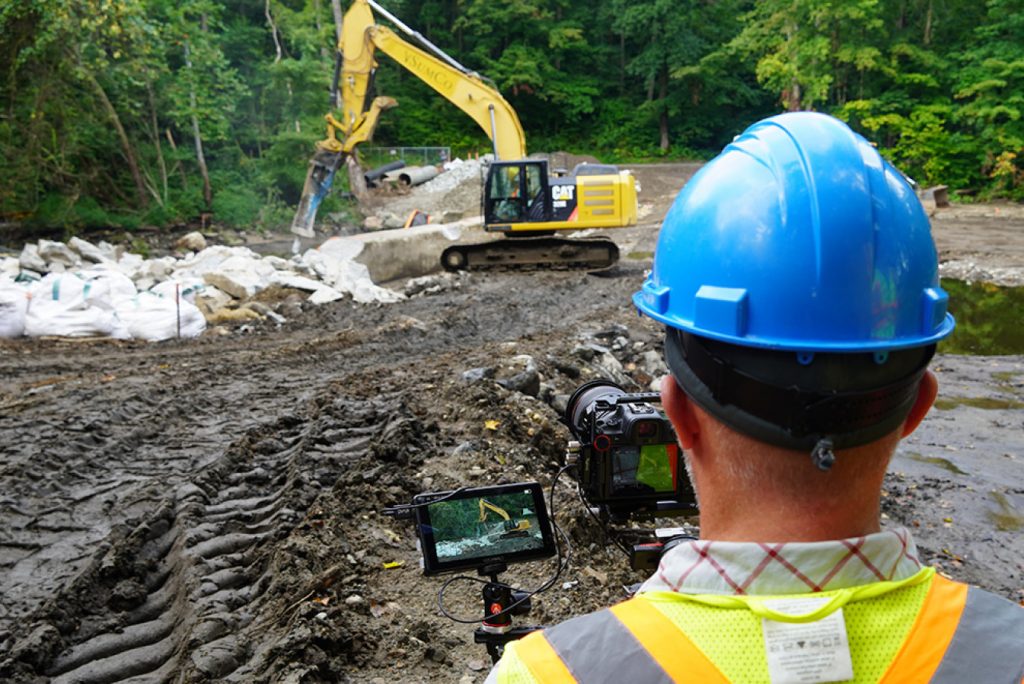By Lindsay Skedgell and David Seigerman

© SavetheSound.org
Melissa Pappas saw what she came to see. Though it wasn’t what everyone else was looking at. Melissa had positioned herself at the back of a pack of thirty people gathered in a dirt clearing in Merwin Meadows Park. The ground was pocked with tire tracks from heavy machinery, on site at long last to take down Dana Dam. For eighty years, the dam in Wilton, CT also known as Strong Pond Dam, had stood in the path of the Norwalk River. On a sunny Monday last September, the crowd of environmentalists, local elected officials, reporters, and community members assembled to witness and cheer the clearing of a concrete obstruction designed to keep nature from doing its thing.
Everyone watched as the excavator extended its enormous arm and began to chisel away at the dam, a major step in a multi-year effort to restore the river. Except Melissa. Rather than focus on one man-made engineering marvel set about demolishing another, Melissa was fixated on the people, listening to their awestruck reactions. She hadn’t expected destruction would be so uplifting.
“Watching their faces as they saw the big yellow machine start drilling out pieces of the dam was the moment of realization for me,” said Melissa, the ecological communications specialist for Save the Sound at the time the Dana Dam project reached fruition. “It was amazing to see all these groups come together to take out a dam, and then to actually do it. Being there with them really connected me to the community.”
During the project, Melissa met a lot of community members and heard firsthand why this 20-year effort meant so much to them. She worked closely with a film crew documenting the dam removal process, listening to stories about the connection people felt to nature. Some of those stories are featured in the documentary Reconnected: Restoring the Rivers of Long Island Sound, which Save the Sound produced as part of its work with the Long Island Sound River Restoration Network, a group of eight NGOs working to remove dams and right-size culverts across the region. The film will highlight the ecological challenges that dams present and the benefits free-flowing rivers have on nature.
The documentary will premiere at “World Fish Migration Day: A Migration Celebration,” to be held Tuesday, May 21 at the Northwest Park Nature Center in Windsor, CT, near the Farmington River. The event is free and open to the public; guests can register in advance at savethesound.org/take-action/upcoming-events/.
The removal of Dana Dam restored ten miles of upstream habitat along the main stem and tributaries of the Norwalk River for resident and migratory fish, such as alewife, blueback herring, and native sea lamprey. These are anadromous fish, which as adults swim upstream from Long Island Sound back to the freshwater riverine habitats where they were born. In order to complete their annual journey—fish run season begins in April—and reproduce, they need passable waterways. Stream barriers interrupting their migration have led to a decline in populations, not only for anadromous fish but for the birds, animals, and predator fish that rely on river herring as a key food source.
Connecticut has more than 5,000 dams—the most per river mile in the country—each one disrupting the functions of free-flowing rivers and causing a cascade of ecological consequences. But they are not the only impediment to thriving river herring runs.
Every year, between 200,000 and 300,000 river herring are caught accidentally in the football field-sized nets of midwater trawlers. Save the Sound’s Long Island Soundkeeper Bill Lucey and other advocates continue to rally support to persuade the New England Fisheries Management Council for strategic closures at certain times and in certain portions of the Atlantic Ocean where these fish, otherwise bound for rivers connected to Long Island Sound, are scooped up before they can reach home to spawn. Reducing this bycatch would help rebuild the river herring runs and improve the population of these keystone species.
For all the meaningful work being done to clear passage for migratory fish, there must be fish to enjoy the freedom of restored rivers. ■



